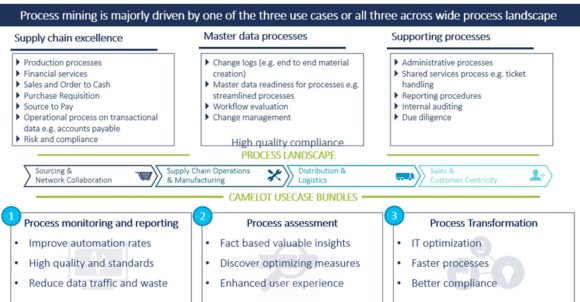The next generation of analytics and tools is changing the way organizations approach problems in their business processes. Organizations and their business models are getting bigger and even more complex each year. With that, the problems of handling the process management are also growing.
Process mining is a leap in solving process inefficiencies, uncover hidden insights, and leveraging those insights to create an intelligent and automated value chain.
How does process mining work?
Process mining uses event data to extract process-related information, such as automatically discovering a process model by observing events recorded by enterprise systems. Process mining techniques use event logs to check conformance, identify bottlenecks and deviations, suggest improvements, and predict processing times.
Process mining not only adds value to classic administration processes, but also in the areas of supply chain excellence, support services and master data management. To identify the key purpose why process mining and where it should be applied, it is crucial to establish a structured view of possible bandwidth. The CAMELOT framework with 3Ps based on process mining (Graphic I) clusters the range of use cases into three main categories:
1. Process monitoring and reporting
Implement one-time monitoring or recurring observation of processes to derive key insights such as deviations, process adherence, non-compliant areas, etc. In addition, process mining can be leveraged in process documentation and reporting.
2. Process assessment
Leverage process mining to either assess the as-is process with a defined process or define a to-be process based on the as-is view. The results of the assessment lead to actionable insights such as improvement measures, realistic process definition and benchmarking. These outcomes serve larger purpose, for instance, increasing operational process efficiency to achieve economic and ecological benefits, substituting mundane tasks and enabling employees to take responsibility for digital transformation based on better process insights, achieving higher customer satisfaction, less rework, faster deliveries, lower transactional cost, less traffic, or less waste.
3. Process transformation
Process transformation is used to analyze processes in strategic transformation programs, e.g., process readiness for Robotic Process Automation, S/4HANA migration, etc. It also enables process transformation through optimization, transparency and compliance.
We at CAMELOT are thrilled about the emerging potential of process mining tools. Companies can very well leverage this potential in their automation journey and gain process efficiencies. However, without the holistic approach, expertise and energy to channel insights into sustainable change, companies risk gaining scant return on their investment in these tools.
Read more about process mining in our next blog article: Making Process Mining Work: Three Key Challenges. – CAMELOT Blog (camelot-group.com)
We would like to thank Geron Keller for his valuable contribution to this article.


